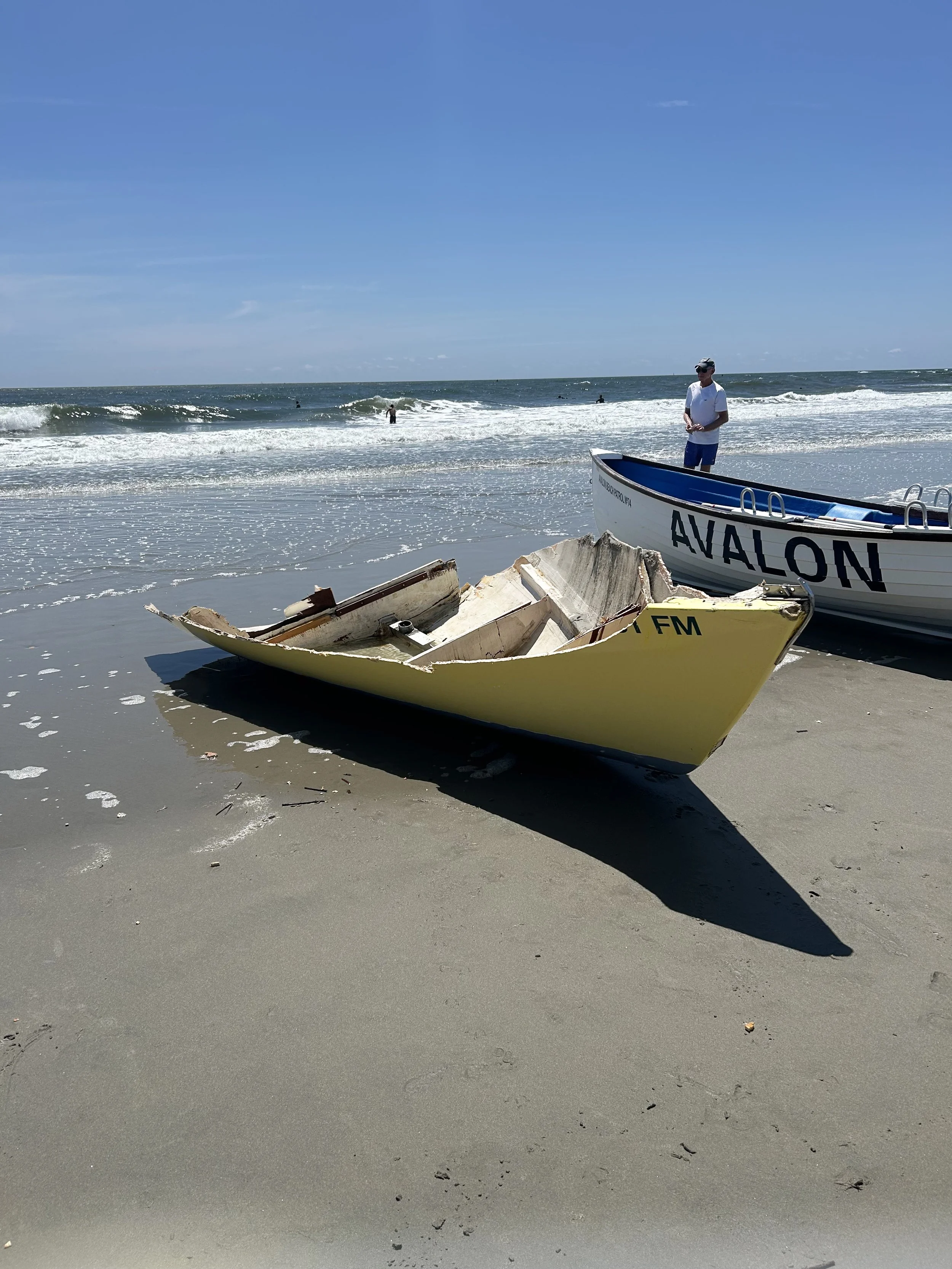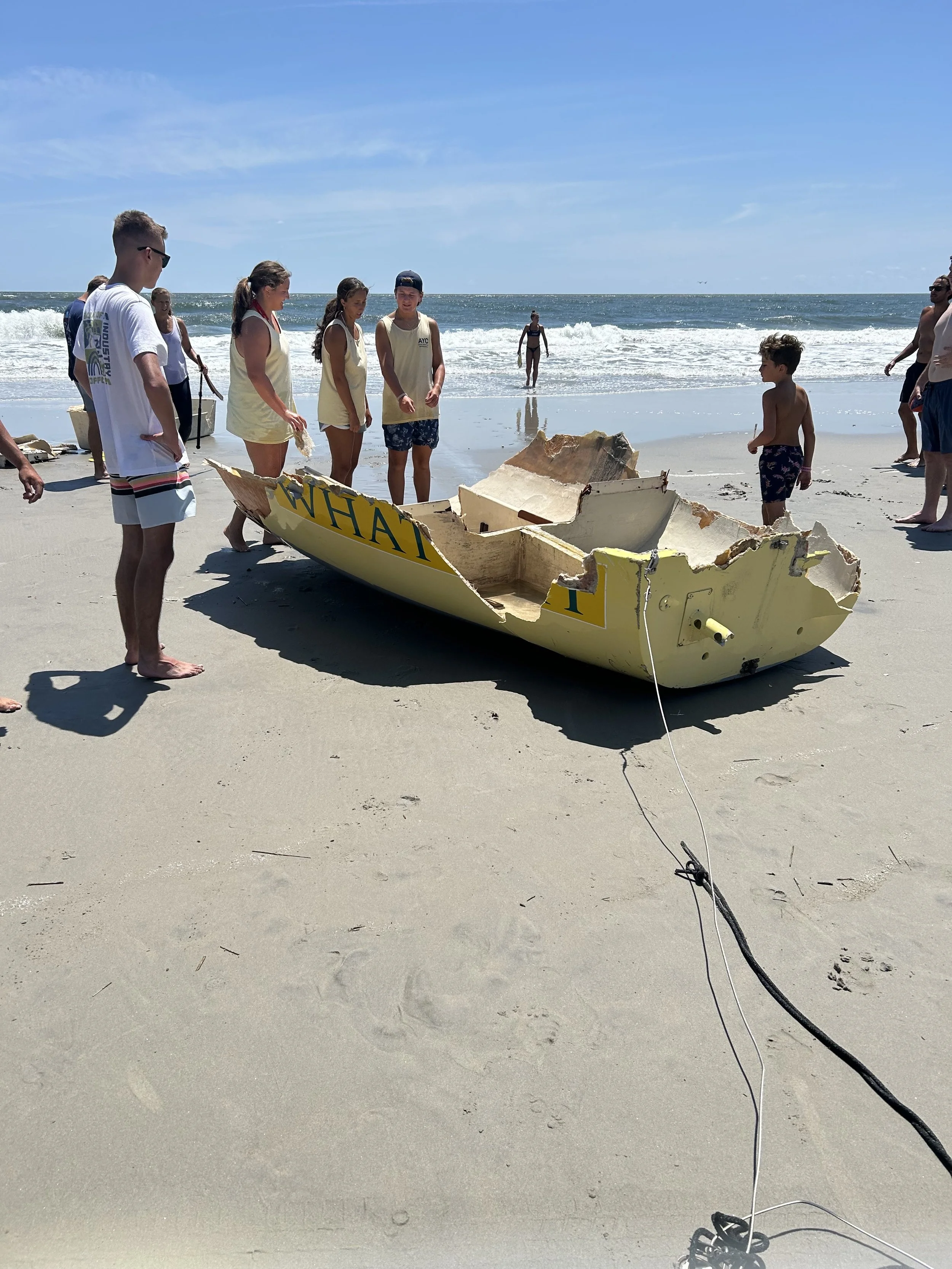Tragedy Averted: 10 Sailors Saved from Jetty Collision
By Jack Byrne
Avalon’s best and bravest helped prevent a tragedy this summer, saving eight teenage sailors and two instructors in Townsend’s Inlet.
“We really couldn’t be happier that the result that came out of that day in the ocean was a positive one,” says Avalon Mayor John McCorristin. “Obviously it could’ve been very tragic. There were young people, teenagers on that boat, but with smart, swift, quick action, everybody made it home safe.”
A sail through Townsend’s Inlet is never an easy task, but high winds and rough seas on Wednesday, July 23 made the journey even more challenging for a group of 10 sailors in training.
That morning, the “What Exit” sailboat of the Avalon Yacht Club, whose crew was comprised of two instructors and eight youth students, took sail upon waves 2 feet in height. “That boat is very capable of handling those 2-foot waves,” says AYC general manager Joe Mendez.
Farther out in Townsend’s Inlet, however, waves were higher than expected, so the instructors decided to turn around. But suddenly their sailboat experienced an engine failure.
“It all happened very quickly,” Mendez says. “They mayday-ed immediately to get rescue to come.”
Without sails raised, the vessel began floating dangerously close to the rocks of the jetty, before violently running aground.
“Townsend’s Inlet is one of the most dangerous bodies of water on the East Coast,” says Matt Wolf, chief of the Avalon Beach Patrol. “That sailboat is not the first one to sink there, and I’m sure it won’t be the last.”
When the Townsend’s Inlet bridge operator was unable to make radio contact with the sailboat, a mayday call was sent to the Avalon Beach Patrol headquarters at 10:57am. The beach patrol was quickly called to action thanks to their beach house operator on duty, third-year lifeguard Jane Hohenleitner, who called out a “Run” to all members of the ABP, alerting all available lifeguards to run toward the site of the incident.
“Every available lifeguard was down there,” Wolf says. “Whether they were doing crowd control, on the jetty, rescue swimmers, or on rescue equipment … We probably had between 40 and 50 lifeguards involved in this rescue.”
Though Wolf and his team remained cool, calm, and collected, the unusual incident was far from stress-free for the veteran lifeguard of 28 years.
“As I came down the street, I could see the mast of the sailboat shaking back and forth, so I knew it was up against the jetty, up against the rocks,” Wolf recalls. “I just thought to myself, ‘This is not going to be good.’”
From the moment the call came in, it was all hands on deck for the beach patrol. ABP not only utilized lifeguards as swimmers in the calmer waters on the south side of the jetty, but also numerous types of watercraft to execute the rescue effort in the rougher waters on the north side of the jetty. This included dispatching their rescue watercraft (RWC), operated by surf rescue technicians Tom Carr and Gary Nagle.
“That piece of rescue equipment, in this particular instance, was invaluable,” Wolf says.
Other key members of ABP’s rescue effort included brothers David and Karl Giulian, who rowed the lifeboat, as well as fifth-year lifeguard Dolan Grisbaum who acted as the lead rescue swimmer.
Now that the beach patrol troops were deployed, there was no time to waste getting the crew of the “What Exit” sailboat to safety. The rescue effort began by third-year lifeguard Austin Carr using his paddleboard to pick up one sailor who had already gone overboard. Nine others, however, remained trapped on the vessel, which continued to pound against the jetty.
Though the sailboat had practically run aground, the best course of action was for lifeguards and rescuers to stay away from the jagged, slimy rocks of the jetty and conduct the rescue from the water.
“The rocks were really slippery, covered in barnacles; it was a lower tide,” Wolf says. “There was no way you could climb down to get into the water, nor would you want to because you would be pinned up against and crushed by those rocks.”
As the “What Exit” continued to aggressively ebb back and forth against the jetty, the beach patrol’s surf-rescue technicians aboard their RWC attempted to pull the sailboat away from the jetty by attaching a tow line to the craft. This first rescue attempt was unsuccessful, but thankfully, the tides turned.
Onlookers describe one powerful wave that caused the damaged sailboat to bounce off the rocks and back into water, deep enough for the crew to abandon ship. The pair of sailing instructors knew this was their best chance at evacuating safely and acted without hesitation.
“The instructors on the boat got the kids into the water because they realized that it was going to be the only way to keep them from becoming injured, or hurt, or worse,” Mendez says.
The sailors, all wearing life jackets, quickly leapt into the sea, and swiftly swam away from the sinking sailboat. Around the same time as ABP made its presence known, another Avalon Yacht Club vessel arrived to assist in the rescue effort. The patrol boat was able to pick up half of the swimming evacuees but couldn’t fit them all aboard.
Because of this, ABP’s surf rescue technicians on the RWC WaveRunner began meticulously transporting the five remaining floating civilians from the rough surf on the north side of the inlet, to the calmer ocean on the south side of the jetty. From there, swimming lifeguards were on standby to intercept and escort the evacuees to shore, where EMTs were waiting to provide medical assistance. While the lifeguards carefully moved their rescued sailors from station to station, the AYC patrol boat was able to transport its five passengers to safety on the sand.
Though the rescue that day was a true group effort by the citizens of Avalon, none of it would have been possible without the brave composure of the sailing instructors.
Says Mendez: “The New Jersey Police investigator that day pulled me aside at the end and said, ‘I don’t care what anybody says to you, your two instructors on that boat are the reason that you have kids with scrapes and bruises, and nothing worse…They’re the reason the kids are safe today.’”
All 10 crewmates of the “What Exit” sailboat were safely rescued, and no injuries were reported thanks to a concerted effort by the Avalon Beach Patrol and Avalon Yacht Club. The good news was reported thoroughly by local news stations such as 6abc “Action News” but was even a lead story on ABC’s “Good Morning America” the following day. Mayor John McCorristin is thrilled with how Avalon and its beach patrol shined in the brightest spotlight.
“It’s a proud moment of course for the Borough of Avalon,” McCorristin says. “We have full confidence in the ladies and men that work for our beach patrol. They’re well-trained, and they have excellent leadership … We’re always proud of them. They don’t always get the recognition outside of when there’s an incident like this, but during the course of the whole year, they’re helping people out on a regular basis on the beach. They do a great job for us.”
A large majority of the work that the Avalon Beach Patrol conducts on a regular basis happens on the beachfront, and this rescue effort was far from ordinary.
“What we deal with, generally speaking, is surf rescue,” Wolf explains. “Last summer, we had over 500 rescues, the summer before that, we had over 900 rescues, but 99.9% of them are happening on the beach, in front of the lifeguards … This was a unique situation, there’s no doubt about it.”
Rescue efforts such as this, or a “special situation” as ABP calls it, occur few and far between. Thanks to thorough and consistent training among senior staff, however, ABP’s lead lifeguards were ready for their time to shine.
“This isn’t a standard rescue for us,” Wolf explains. “A sailboat in the inlet, crashing into the rocks, is not something that we train day-in and day-out for … We spend a little bit of time training on it, but 90% of our training is dedicated to what’s going on right in front of us in the water.”
Though the majority of ABP’s training is focused on beach rescue, their less frequent specialized training was crucial during this rare incident. In order to prepare for an open ocean rescue such as this, Wolf and his team of lieutenant and captain lifeguards typically choose days of rough water closer to hurricane season to better simulate a perilous rescue. Given Townsend’s Inlet’s treacherous nature, however, the team has to practice in that body of water when it’s calmer.
“We do rough water training every year,” Wolf notes. “You have to wait for the right day. Usually, we wait until August … and we do it very guarded. We watch, we talk them through it … As far as the inlet goes specifically, we pick calm days, and a couple times a summer, we go out there and we put a rescue doll or one of our officers out there in the inlet, and we have the guards respond.”
Wolf credits his lifeguards’ skill and execution on the rescue watercraft to Captain Ryan Black, a veteran lifeguard of 19 years, who leads their RWC training. Though he wasn’t physically present at the scene, his impact on the situation was still felt. “The training that he did with those guys allowed them to be able to go down there and be effective in that situation,” Wolf says. “Their training really came in handy that day.”
An abundance of training isn’t limited to the lifeguards, however, as the Avalon Yacht Club’s sailing instructors go through rigorous safety exercises as well. “While we haven’t ignored, obviously, the accident, and the lessons to be learned from it, we really want to focus on the fact that we train our instructors really well,” Mendez says. “We reimburse and pay for them to go through more significant training from outside sources. Even this year, we brought in the Avalon EMS to do a whole day with them.”
Strong leadership and courageous actions were on display in Townsend’s Inlet that day.
The people of Avalon are safer today thanks to the Avalon Beach Patrol, and members of the Avalon Yacht Club can rest assured knowing that they have quick-thinking and skillful leaders. As Matt Wolf puts it, “That skill comes from training. Training saves lives, and it did that day.”
Readers can continue seeing the great work done by both of these organizations by following @AvalonBeachPatrol on Instagram and @AvalonYachtClub on Instagram and Facebook.
More than 2.3 million viewers learned of the heroics in Avalon when ABC’s “Good Morning America” led its 7am broadcast with news of the rescue in Townsend’s Inlet. The “Good Morning America” newscast is the morning’s top-rated news broadcast in America. Video of the rescue was also reported on multiple broadcasts by 6ABC, NBC10, CBS3, FOX29 and PHL17 in Philadelphia as well as News12, ABC7 and NBC4 in New York. The story was reported by television stations all over the country such as 7ABC in Chicago, WSVN in Miami and KTVZ in Bend, Ore. In all, the positive news of the heroic rescue in Avalon likely reached more than 8 million people throughout the United States.




